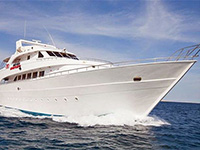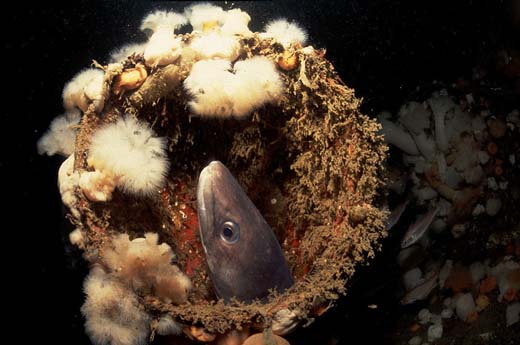Reviews: "Love the newsletters! Keep them coming" Janice Fleming...MORE REVIEWS

Threatened Fish Species to Avoid Eating
With fish like cod, haddock and grouper now listed as endangered by the IUCN, many people are worried about eating them. Other concerns for divers are those fish which are associated with high levels of by-catch. This is where animals like dolphins and turtles are killed accidently in the nets. This table, reproduced with the permission of the Marine Conservation Society, lists the top 20 species to avoid.
Species |
Reason |
Alternatives |
|---|---|---|
| Just about all conger eels which are caught in fishing nets are juveniles which have not yet reached spawning age. |
None |
|
|
Atlantic salmon |
Wild stocks reduced by 50% in last 20 years |
Wild Pacific salmon. Responsibly and/or organically farmed salmon. |
|
Chilean seabass (Patagonian toothfish) |
Species threatened with extinction by illegal fishing, also high levels of seabird bycatch. |
None |
| Species listed by IUCN** |
None |
|
|
*European Hake |
Species heavily overfished and now scarce |
South African hake (M.capensis) |
| Trawl fisheries target pre-spawning & spawning fish also high levels of cetacean by-catch |
Line caught or farmed seabass |
|
|
Grouper |
Many species are listed by IUCN** |
None |
|
*Haddock (from overfished stocks) |
Species listed by IUCN** |
Line caught fish from Icelandic & Faroese waters |
|
*Ling (molva spp) |
Deep-water species and habitat vulnerable to impacts of exploitation & trawling |
None |
| Many species are listed by IUCN** |
None |
|
| Long-lived species vulnerable to exploitation. Mature females extremely rare |
None |
|
|
North Atlantic halibut |
Species listed by IUCN** |
Line caught Pacific species. Also farmed N Atlantic halibut. |
| Very long-lived species vulnerable to exploitation |
None |
|
|
Shark |
Long-lived species vulnerable to exploitation |
None |
|
(Rajidae spp) |
Long-lived species vulnerable to exploitation |
None |
|
Snapper (Lutjanus spp) |
Some species listed by IUCN**, others over-exploited locally |
None |
|
Sturgeon |
Long-lived species vulnerable to exploitation. 5 out of 6 Caspian Sea species listed by IUCN** |
None although this species is now farmed |
|
Swordfish |
Species listed by IUCN** |
None |
| All commercially fished species listed by IUCN except skipjack & yellowfin which is over-fished |
"Dolphin Friendly" (EII monitored) skipjack or yellowfin. Preferably pole & line caught. |
|
|
Warm-water or tropical prawns |
High by-catch levels and habitat destruction |
Responsibly farmed prawns only |
* Stocks assessed by ICES
(International Council for the Exploration of the Sea) as outside Safe
Biological Limits i.e. the limits for fishing mortality rates and spawning
stock biomass (the total weight of all sexually mature fish in a population)
beyond which the fishery is unsustainable.
** IUCN - The World Conservation Union - listing for most species is
Endangered. Southern bluefin tuna is assessed as Critically Endangered.
| Conger Eel (Conger conger) This massive fish can grow to almost 3 m (10 ft) long, the females often being bigger than the males. Congers breed only once in their lives, commonly when they reach 5 years old, after which they die. As they breed only once, just about all eels which are caught in fishing nets are juveniles which have not yet reached spawning age. They only become sexually mature during the journey to the spawning areas. back to table
|
| Atlantic
cod (Gadus morhua) Cod is a cold-temperate (boreal) species. It belongs to the family of fish known as gadoids. In the North Sea cod reach maturity at about 4-5 years old at a length of approximately 50cm. All stocks - including North Sea stock - are outside safe biological limits. Atlantic cod is assessed as Endangered by IUCN - the World Conservation Union. Only stocks around Iceland are currently harvested sustainably. back to table |
| Ling
(Molva spp.) Ling (Molva molva) and Blue Ling (Molva dypterygia) - a relative of ling found in deep-water - are both cod-like species. Stocks for both these species are over-fished and outside safe biological limits. Blue ling as with all deep-water species is particularly vulnerable to over-fishing as it grows slowly, lives for a long time - up to 20-30 years - and matures at a high age - 5-6 years. back to table |
| Dogfish
or Spurdog (Squalus acanthius) Dogfish are elasmobranchs and belong to the same family as sharks and rays. Dogfish give birth to live young. The species is particularly vulnerable to over-fishing. Species is assessed as at Lower Risk (close to meeting threatened thresholds) by IUCN. Dogfish sold as rock salmon or huss - flake is a popular name for it sold battered and deep-fried in fish and chip shops. Nursehound and lesser-spotted catshark also sold as dogfish. back to table |
| Haddock
(Melanogrammus aeglefinus) Haddock - another gadoid species - is an important commercial species throughout the North Atlantic. Smaller than cod it can attain a maximum length of 76-100cms. The legal landing size is just 30cms. Many stocks are exploited at very high levels. This species is assessed as Endangered by IUCN. As with most mixed demersal fisheries the fishery for haddock (and cod) is associated with high levels of discarding of undersized or immature fish and fish for which there is very small or no quotas. back to table |
| Marlin
There are four species of Marlin of which 2 - the blue and black marlin - are found in the Atlantic. They are usually solitary animals found in deep blue-water and are highly migratory traveling long distances. Both Atlantic species are at low stock levels. The white marlin is the most threatened and in danger of extinction. Method of fishing is long-lining associated with by-catch or accidental capture of sharks and marine turtles etc. back to table |
| Monkfish
(Lophius piscatorius) Monkfish - which is found in waters over the continental shelf and in deep-water beyond the shelf slope - is another species particularly vulnerable to overfishing. Females do not mature until they are around 9-11 years at a length of about 70cms. There is no landing size specified for this species and as a result high quantities of fish landed are immature. Mature females are now extremely rare. The fleshy tail is the only part of the animal eaten - the large head is discarded. Lucrative species popular in restaurants. back to table |
| Orange
Roughy (Hoplostethus atlanticus) Orange roughy is a deep-water species found in deep cold waters to 1000 meters. It has very slow growth, great longevity - it is one of the longest lived fish known and may live for 125 years - and low fecundity. Atlantic stocks are over-fished and outside safe biological limits. Trawling over seamounts and coral banks inhabited by these fish are vulnerable to damage by fishing gears. Very little is known about the impact of fishing on the deep-water ecology. back to table |
| Seabass
(Dicentrarchus labrax) Seabass is both a valuable commercial and recreational species. Commercial exploitation has escalated in recent years decimating numbers of mature wild fish. The fishery targets spawning and pre-spawning fish before they have had a chance to breed. The main commercial method of capture for wild caught seabass is mid-water pair trawling. This method of fishing is responsible for high levels of dolphin kills. Many of the dolphins taken in this fishery are washed up dead on our beaches. back to table |
| Skates
& Rays (Rajidae spp.) Common species sold as skate are the common skate and the thornback ray or roker. Common skate is assessed as Endangered by IUCN and thornback ray as at Lower Risk. Rajidaes are cartilaginous species belonging to the same group as sharks and dogfish. They are particularly vulnerable to over-fishing because of their low fecundity and high age at first maturity. Longevity in common skate is estimated at 50 years. back to table |
| Tuna There are six commercially important species of tuna. It is highly sought after and forms the basis of many fisheries world-wide. Tuna are large, oceanic fish and are seasonally migratory, some making trans-Atlantic journeys. The main methods of capture are purse-seine net and long-line. Fishery for yellowfin in Eastern Tropical Pacific most commonly associated with by-catch of dolphins. Northern bluefin, Southern bluefin, bigeye and albacore tuna are all listed by IUCN - Southern Bluefin tuna is assessed as Critically Endangered. back to table |
The Marine Conservation Society (MCS) is a charity dedicated to the protection of the marine environment and its wildlife.


